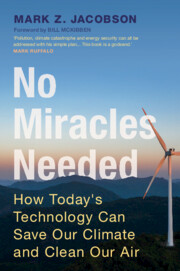Book contents
- No Miracles Needed
- Reviews
- No Miracles Needed
- Copyright page
- Dedication
- Contents
- Figures
- Foreword
- Preface
- 1 What Problems Are We Trying to Solve?
- 2 WWS Solutions for Electricity Generation
- 3 WWS Solutions for Electricity Storage
- 4 WWS Solutions for Transportation
- 5 WWS Solutions for Buildings
- 6 WWS Solutions for Industry
- 7 Solutions for Nonenergy Emissions
- 8 What Doesn’t Work
- 9 Electricity Grids
- 10 Photovoltaics and Solar Radiation
- 11 Onshore and Offshore Wind Energy
- 12 Steps in Developing 100 Percent WWS Roadmaps
- 13 Keeping the Grid Stable with 100 Percent WWS
- 14 Timeline and Policies Needed to Transition
- 15 My Journey
- References
- Index
8 - What Doesn’t Work
Published online by Cambridge University Press: 02 February 2023
- No Miracles Needed
- Reviews
- No Miracles Needed
- Copyright page
- Dedication
- Contents
- Figures
- Foreword
- Preface
- 1 What Problems Are We Trying to Solve?
- 2 WWS Solutions for Electricity Generation
- 3 WWS Solutions for Electricity Storage
- 4 WWS Solutions for Transportation
- 5 WWS Solutions for Buildings
- 6 WWS Solutions for Industry
- 7 Solutions for Nonenergy Emissions
- 8 What Doesn’t Work
- 9 Electricity Grids
- 10 Photovoltaics and Solar Radiation
- 11 Onshore and Offshore Wind Energy
- 12 Steps in Developing 100 Percent WWS Roadmaps
- 13 Keeping the Grid Stable with 100 Percent WWS
- 14 Timeline and Policies Needed to Transition
- 15 My Journey
- References
- Index
Summary
Aside from implementing WWS and storage technologies, the main suggestions for reducing or eliminating energy-related emissions have included using natural gas for electricity instead of coal, using natural gas or coal with carbon capture, using nuclear power instead of fossil fuels for electricity, using biomass with or without carbon capture for electricity, using liquid biofuels instead of gasoline or diesel for transportation, and using blue instead of green hydrogen. Non-energy-producing methods have also been proposed to remediate global warming. These include primarily synthetic direct air carbon capture and geoengineering. Policies that include these technologies along with WWS technologies are referred to as “all-of-the-above” policies, since they involve promoting most all technologies, regardless of their side effects, cost, effectiveness, or length of time between planning and operation. The justification for using these technologies is that they are a bridge between current carbon-intense technologies and WWS. This chapter discusses these non-WWS technologies and delineates the reasons why they are not needed or helpful for solving global warming, air pollution, and energy security problems.
Keywords
Information
- Type
- Chapter
- Information
- No Miracles NeededHow Today's Technology Can Save Our Climate and Clean Our Air, pp. 129 - 191Publisher: Cambridge University PressPrint publication year: 2023
